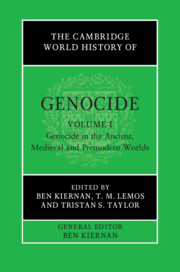Book contents
- The Cambridge World History of Genocide
- The Cambridge World History of Genocide
- The Cambridge World History of Genocide
- Copyright page
- Contents
- Figures
- Maps
- Tables
- Contributors to Volume I
- General Editor’s Acknowledgements
- General Editor’s Introduction to the Series
- Introduction to Volume I
- Part I Themes of Genocide through History
- Part II The Ancient World
- Part III The Medieval World and Early Imperial Expansions
- 15 William the Conqueror’s Harrying of the North, 1069–1070
- 16 Genocidal Massacres of Jews in Medieval Western Europe, 1096–1392
- 17 Crusaders and Mass Killing at Jerusalem in 1099
- 18 The Albigensian Crusade and the Early Inquisitions into Heretical Depravity, 1208–1246
- 19 Mongol Genocides of the Thirteenth Century
- 20 Việt Nam and the Genocide of Champa, 1470–1509
- 21 Genocidal Massacres in Medieval India
- 22 Mass Extermination in Prehistoric Andean South America
- 23 The Spanish Destruction of the Canary Islands
- 24 Genocidal Massacres in the Spanish Conquest of the Americas
- Index
15 - William the Conqueror’s Harrying of the North, 1069–1070
What, If Not Genocide?
from Part III - The Medieval World and Early Imperial Expansions
Published online by Cambridge University Press: 23 June 2023
- The Cambridge World History of Genocide
- The Cambridge World History of Genocide
- The Cambridge World History of Genocide
- Copyright page
- Contents
- Figures
- Maps
- Tables
- Contributors to Volume I
- General Editor’s Acknowledgements
- General Editor’s Introduction to the Series
- Introduction to Volume I
- Part I Themes of Genocide through History
- Part II The Ancient World
- Part III The Medieval World and Early Imperial Expansions
- 15 William the Conqueror’s Harrying of the North, 1069–1070
- 16 Genocidal Massacres of Jews in Medieval Western Europe, 1096–1392
- 17 Crusaders and Mass Killing at Jerusalem in 1099
- 18 The Albigensian Crusade and the Early Inquisitions into Heretical Depravity, 1208–1246
- 19 Mongol Genocides of the Thirteenth Century
- 20 Việt Nam and the Genocide of Champa, 1470–1509
- 21 Genocidal Massacres in Medieval India
- 22 Mass Extermination in Prehistoric Andean South America
- 23 The Spanish Destruction of the Canary Islands
- 24 Genocidal Massacres in the Spanish Conquest of the Americas
- Index
Summary
William I’s ‘Harrying of the North’ was a military expedition against local rebels and a Danish invasion force in the winter of 1069–70. It has been regarded since the 1870s as a uniquely savage treatment of the English inhabitants of northern England, wantonly destructive of life and the means of sustenance, and tantamount to genocide. Such views derive from the two fullest medieval accounts, by the early twelfth-century historians Symeon of Durham and Orderic Vitalis. However, neither was an eye-witness, both were at work two generations later, and both had their own agenda in describing the destruction of the North and William I’s cruelty. The Harrying should instead be seen as a routine military operation which took place, unusually, in the depths of winter, and so had unusually severe consequences. More strictly contemporary accounts from Evesham and Beverley reveal a regional but probably localized famine and a refugee crisis. Further, the record in Domesday Book (1086) of many Yorkshire villages as ‘waste’ should be read as referring not to physical destruction but to the absence of surplus values accruing to landlords, and not caused by the Harrying alone. The Harrying of the North was no genocide.
Keywords
- Type
- Chapter
- Information
- The Cambridge World History of Genocide , pp. 403 - 424Publisher: Cambridge University PressPrint publication year: 2023

